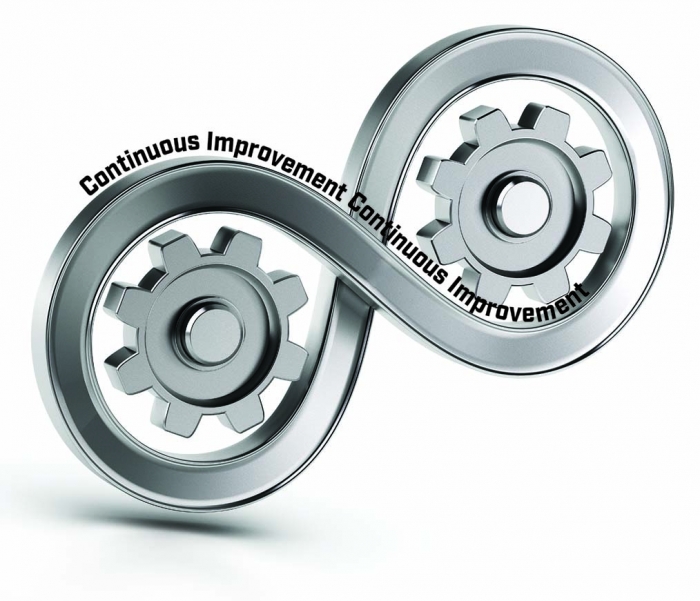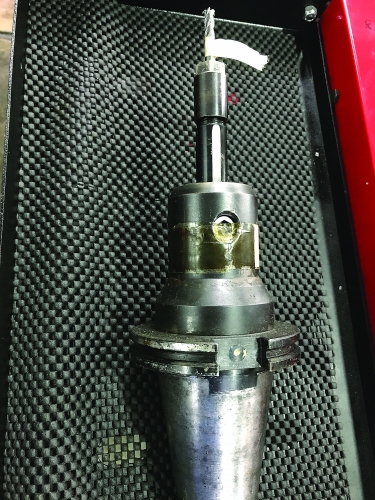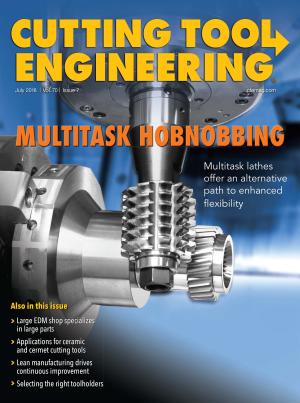To the uninitiated, the concepts behind lean manufacturing may seem cold and impersonal, a jumble of numbers, percentages and statistics far removed from the individual actions of people.
Nothing could be further from the truth.
To become lean, “you’ve got to change how people think, how they’re viewing what they’re doing and how they’re doing it,” said Chris Piagari, continuous improvement and manufacturing engineering manager at Lake Bluff, Ill.-based Liquid Controls LLC, which manufactures flow meters and accessories. “To develop a continuous improvement culture, it takes time and it takes growth: growth of the people, growth in their knowledge, growth in changing the perspective of how they do things.”
People experienced with lean—such as Piagari, who has been involved with its teachings for 20 years—often use the word “culture.” In other words, lean’s focus is on a company’s employees and their behavior, and lean is a way to optimize the efficiency of people’s actions.

The goal of continuous improvement also comes up a lot.
“The overall objective of what we’re trying to do with lean is we want to develop a continuous improvement culture within each business unit,” Piagari said.
Liquid Controls is a unit of Lake Forest, Ill-based IDEX Corp., which manufactures fluidics systems and components. For several years, the company and its business units have built a lean culture driven neither from the top down nor from the bottom up but in a more blended or organic way. This diffuse approach has resulted in decentralized yet thorough support for lean.
“I’m not saying that’s best practice,” said Troy Weber, corporate lean/continuous improvement manager at IDEX, “but that’s just what works for us.”
In any lean implementation, he said, whether adopting a single, minor change or altering an entire production system, existing organizational structures must be taken into account to achieve corporatewide success.
“These businesses are pre-existing,” he said. “They have pre-existing cultures. They have ways of doing things. We customize our approach with lean to them. It’s not a cookie-cutter approach.”
Rapid Improvement
Piagari cited improving on-time delivery of one product to one customer by 25 percent as an example of how a little lean can go a long way. In this case, deliveries last year were on time for 70 percent of the customer’s orders of the product. Liquid Controls developed a lean transformation plan for the production floor to improve the flow of materials from the moment that an order is received until the moment it leaves the shipping dock. About a month of initial planning was followed by a weeklong kaizen—a synonym for continuous improvement—event, after which the new process was implemented over a few weeks.
“It really boils down to understanding the product line: the processes to build that product line, the customer demand for building that product line and the processes that will deliver that product to the customer when they want it,” he said.
The gathering and communicating of all that data does not imply that insights are a one-way street from management to the shop. A cross-functional team of trainers and trainees is required to fully comprehend and design a plan.
“The people involved in that work cell are trained but provide their own feedback, of course,” he said. “They were in the kaizen event—we call them rapid improvement events—for the whole week of training. We all brainstorm.”
By better utilizing the work cell and streamlining the flow of materials, on-time delivery of the product to the customer was increased to more than 95 percent. From the time of the order to the time of shipment, the product used to take 5 days to process. After the 2-month lean transformation, start-to-end time was less than a day. Coincidentally, in the months after the project, the customer had a big spike in demand, which Liquid Controls easily absorbed because of the newly established lean process.
“In the past, mad scrambling would have taken place to get the order out,” Piagari said. “We would have missed deliveries and had high amounts of overtime. Thanks to having this cell in place, we were able to finish the orders in a shorter amount of time and with less overtime.”
He said similar lean transformation plans were performed for the rest of the core product lines that involved the highest-volume products and, thus, received the biggest benefits from lean.
The State of Lean in the States
Phillip Canipe, vice president of sales and business development for the Southwest region at Stellar Industrial Supply Inc., Tacoma, Wash., has been involved with lean since 1984. He said the state of lean in U.S. manufacturing at many large, seasoned corporations with high-volume production is decent. The subcontractors and small shops are where lean is lacking.
“But even the large manufacturers often have a lot of waste,” he said. “There’s always room for advancement to make things more innovative and world-competitive. I think we’ve got a long way to go, with more training, more awareness and more control as the aging, highly skilled, highly experienced workforce is retiring. There are many trainings occurring, and there’s an awareness within STEM and at engineering and business schools, but there’s a gap.”
Canipe said manufacturers of all sizes have no choice in the long term but to go lean.
“If they don’t do this,” he said, “then some emerging market with lower workforce costs or material costs is going to take their lunch money. Improving processes and controls gives the chance to have more net profits, to get it through their shop faster with less scrap and without having to add a bunch of extra money to the supply chain.”
Fat Obstacles
Common factors tend to trip up people and companies on their way to establishing a lean culture. For instance, Weber said commitment is key. Gaining commitments of time and resources toward continuous improvement projects can require persuasive arguments and negotiations on the parts of believers. Another important point is sustainment.
“That’s one of the most overlooked pieces of improvement,” he said. “You finish up with a weeklong event, and you feel like you’re done with it. But you’re not. You’re really halfway through. You have to make it a habit and make sure that issues are being addressed until it becomes a habit.”
Canipe said 90 percent of companies are reluctant to re-examine processes that already have been inspected and improved.
“In their mind, they think it’s in control,” he said. “They leaned it out and think it’s fine since 6 months ago. The time to start the next lean event and process improvement is right after you’ve celebrated the win you just completed.”
The “continuous” in continuous improvement means just that: It never ends. So instead of viewing unattainable perfection as the goal, it helps to consider ongoing progress as a better barometer of success.
“Are you working more directly with your customers, and are you working on things to improve them and the overall market?” Piagari said.
On the individual project level, Weber said victory is attained when a team has embraced a new process and that work is streamlined and smooth. However, from the long-term perspective, he said the mentality must be that improvements are never finished.
“But you can consider yourself in good shape when the buy-in is there and change is the way you do things from now on,” he said. “Change is normal.”
Canipe said setting goals that can be measured is important to maintain motivation, especially at companies that at first experience big returns from lean but subsequently find it difficult to maintain the pace of improvement.
“I see companies hitting those metrics year after year after year,” he said. “It may require expenses, like investing in newer tools, but you’re paid back. That’s the other trap: People look at it as something we succeeded with in the past. People look at it as an event, not as a culture or a way of life.”
For Piagari, it always comes back to team effort.
“They have to see where the company is going to improve efficiencies and to help customers
get what they want,” he said. “It takes the collaboration of all the different people within our company to get that done. We look at lean as a way to drive broad excellence and customer satisfaction in our business.”
Machining Process Issues to Consider
By Phillip Canipe,
Stellar Industrial Supply Inc.
Manufacturing economics should be job one for any plant manager or owner. Indeed, reducing time and increasing throughput are the keys to driving proper, efficient production. But this is no easy task, especially if old habits and ways have become ingrained. Generally speaking but particularly if undergoing a kaizen or other lean event, always look to ask questions, such as “Is there a way to do it twice as fast, or is there a way to drive 30 percent out of the cost?” Sometimes, the answer lies with how the cutting tool is held, how the part is held or how tools are driven. To get started, here are some important machining process issues to consider upfront:
Machine type and condition. Is the machine new or old? Is it well-maintained?
Spindle taper. Look at standards, including CT, HSK, BT, Capto and KM.
Maximum spindle rpm. Consider 95 percent of the maximum as the upper limit.
Horsepower and torque curve. Make sure to review manuals and find the optimal curve.
Maximum controlled feed rate and rapid feed rate. Use the machine’s established maximum, as programming the machine higher will not improve the process.

If a toolholder’s taper looks like this, the inside of the machine spindle matches it.
Image courtesy of Stellar Industrial Supply
Total indicator runout of spindle. Determine if the machine’s spindle runout has been measured with a gage bar.
Retention knob torque. Note that a pull stud will have a maximum torque specification. Overtightening can damage the spindle and increase runout.
Draw bar tension. Is it within the minimum specs from the machine manufacturer? Is it checked and tracked on a regular basis?
Fixture method. Is it rigid? Does it have a long overhang? What is the level of engagement?
Workpiece material hardness. What is the maximum surface speed at which the machine can run?
Machining operations that require 80 percent of total cycle time. This is a no-brainer: Focus on the machines and processes that make up the bulk of production.
Current planned cycle time. Know which key thresholds critically impact profitability.
Chip-to-chip cycle time, including tool changes. Again, understanding these metrics is important for improving throughput.
Takt time. In lean, this term refers to the rate of the complete process from start to finish, including the operator’s time from the beginning to the end of the process, not just the machining.
Surface finish requirements. Don’t machine for a 32-rms finish when 125 rms is on the print. Oftentimes, this process can be sped up.
In-process gaging needs. To save additional time, during setup, prepare all the tools you need.
Tool life history. Have you made the part before? If so, what was the observed average tool life?
Tool wear and feature control identifiers. Focus on any feature type and tolerance, no matter how small the increment.
Unique process awareness. For any special requirements upstream, make sure to put them into the overall scheme, as they will affect time and throughput.
Related Glossary Terms
- feed
feed
Rate of change of position of the tool as a whole, relative to the workpiece while cutting.
- fixture
fixture
Device, often made in-house, that holds a specific workpiece. See jig; modular fixturing.
- hardness
hardness
Hardness is a measure of the resistance of a material to surface indentation or abrasion. There is no absolute scale for hardness. In order to express hardness quantitatively, each type of test has its own scale, which defines hardness. Indentation hardness obtained through static methods is measured by Brinell, Rockwell, Vickers and Knoop tests. Hardness without indentation is measured by a dynamic method, known as the Scleroscope test.
- in-process gaging ( in-process inspection)
in-process gaging ( in-process inspection)
Quality-control approach that monitors work in progress, rather than inspecting parts after the run has been completed. May be done manually on a spot-check basis but often involves automatic sensors that provide 100 percent inspection.
- lean manufacturing
lean manufacturing
Companywide culture of continuous improvement, waste reduction and minimal inventory as practiced by individuals in every aspect of the business.
- tolerance
tolerance
Minimum and maximum amount a workpiece dimension is allowed to vary from a set standard and still be acceptable.
- total indicator runout ( TIR)
total indicator runout ( TIR)
Combined variations of all dimensions of a workpiece, measured with an indicator, determined by rotating the part 360°.
Contributors
IDEX Corp.
(847) 498-7070
www.idexcorp.com
Liquid Controls LLC
(800) 458-5262
www.lcmeter.com
Stellar Industrial Supply Inc.
(800) 562-8258
www.stellarindustrial.com


